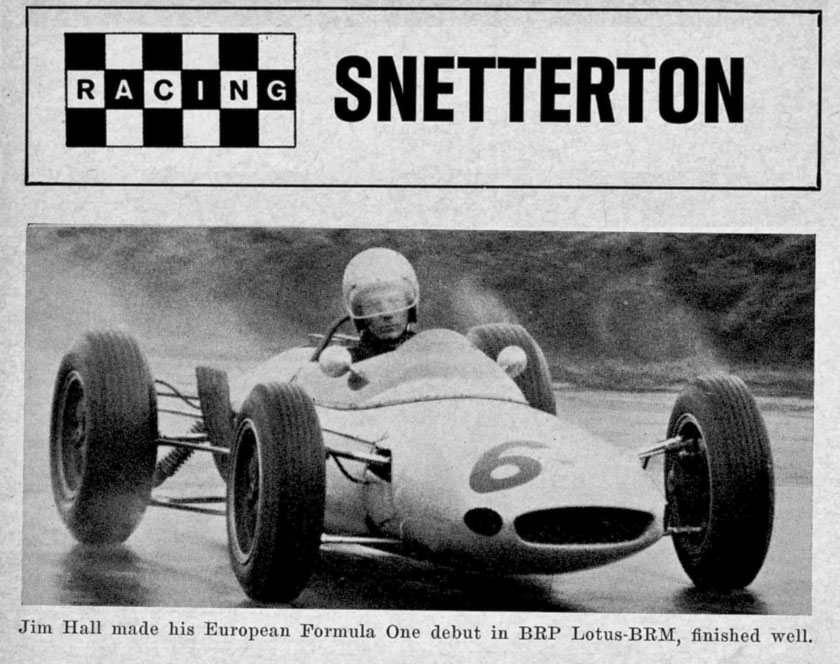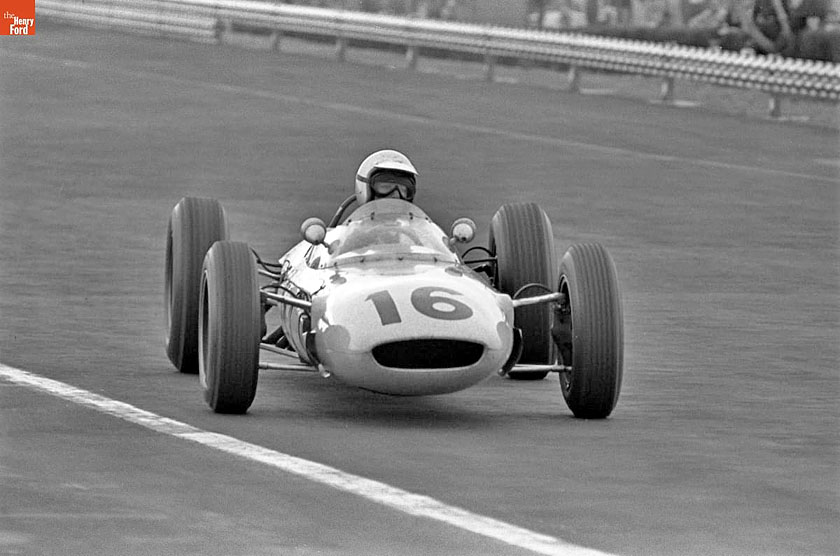





Jim Hall talks Chaparral to MOTOR RACING
was like a kind of expensive Junior. There we suffered from using someone else’s engine, and I wasn’t too happy with it. I haven’t driven a current Fl car, but I should think that they are much better. I did drive a 2£ liter Lotus-my own-in the I960 US GP, and 1 enjoyed that. But I think that Fl suffers from its restrictions. Certainly Group 7 is a damn fine class because it’s virtually unrestricted.’
How do you rate your Group 6 rivals at the moment? Who do you think presents the greater opposition – Ford or Ferrari?
‘I’m glad you think we’re in a position to have opposition like Ford and Ferrari. But they’re very different, with Ford going all out to win Le Mans and Ferrari more Championship oriented. But they seem to be missing a lot of the qualifying races – it’s a shame.’
Which do you regard as Chaparral’s finest win yet, and why?
‘Sebring in ’65, but mainly because I was driving there. I wasn’t at the Nürburgring when we won last year.’
What has been your most disappointing outing yet with the Chaparrals?
‘Sebring last year when the cars were spewing oil everywhere and went out early on; I was very discouraged.’
Without any profits from selling production cars at the moment, how is Chaparral financed?
‘Well, we get a lot of sponsorship from Firestone, Shell, Bosch, the Cox model company and so on, but we’re still not a rich team. That’s the reason for running only one ‘car in most European races, instead of several as we would like.’
You have a private test track at your Midland, Texas, works. Do you find it a great advantage, and what kind of test equipment do you use?
‘Oh yes, the test track’s very valuable. We can make any slight modification, wheel the car on to the track and see exactly what the effect is in a few minutes, rather than having to trail the car to some other circuit.
Our test equipment includes 14 different speed traps set up around the track, recording speeds, acceleration out of corners and so on.’
How many people make up the regular Chaparral racing crew, and who is responsible for team administration?
‘We have 19 employees in all, counting myself, and we usually have five mechanics and three helpers at the meetings. We usually shuffle round the helpers at home so that everyone who works for us has an Idea of what our racing is all about. My wife, Sandy, is in charge of administration, and does a lot of other things too, like timekeeping and even the upholstery in all our cars. She’s kind of useful to have around.’
Which driver (of your cars or anybody else’s) do you rate highest at present?
‘I’ve got the highest regard for Dan Gurney. He’s a driver who can do equally well in anything he drives, from a stock car to a sports-racer or an Fl, but Phil Hill is really good too.’
Trade sponsorship of race meetings and championships, and advertising on cars in the States seems to have put a lot of money into the sport over there that is lacking in Europe. Do you think that such support would be of much advantage to racing over here?
‘You mustn’t forget that for these big money races, there is no starting money system – you have to win what you get, and so there isn’t so much more money in the sport in the States. But advertising on cars brings in revenue, and it all helps you race. I don’t object to advertising like this at all – it could be a good thing in Europe.’
As a pioneer in the use of automatic transmissions on competition cars, do you think the manual gear shift will soon be a thing of the past?
‘No, I doubt it. Car development tends to go in waves, and at the moment we’re on a wave which makes an automatic suit our needs. But in a while the manual might be more suitable – I can’t see it being replaced just like that.’
General Motors has been said to be actively, but quietly, supporting Chaparral for several seasons now – to what extent do they support you, if at all?
‘We get no direct support at all. We just know a few people and get some things we need, but it’s not support from board level at all. If anything, they’re opposed to our racing.’
Do you regard the Can-Am type sports car events as a good testing ground for ideas to use in European racing, or European racing as a good testing ground for ideas to use in Can-Am type racing?
‘Oh, we use Can-Am and USRRC as a test ground for our European programme rather than the other way around. Le Mans is the race we would really like to win, and that’s what we’ve been working for. But you’ve got to be flexible, and Can-Am can be profitable.’
With Chaparral design, construction, testing and racing obviously taking up so much of your time, do you have any other hobbies?
‘No, none at all. Working on the cars is a full-time job.’
———————————————————————
‘The Chaparral’s coming’, seems to be one of the major recommendations for seeing the BOAC 500-mile race at Brands Hatch on July 30, and in a few years these cars have won a formidable reputation for themselves. Based in Midland, Texas, Chaparral Cars is run by Jim Hall and Hap Sharp – both successful sports and prototype car drivers in their own right. Midland is an oil town and Hall is an oil man. After racing cars ranging from a Ferrari Monza to a ’56 Corvette and an XK 120-M while at college, Hall joined Carroll Shelby in a Dallas sports car agency. He raced a vast variety of cars all over the US, doing it for the enjoyment, but always trying to ensure he had the best car for the job, being described on one occasion as driving for fun, but saying, ‘. . . it’s not fun unless you do it well’. Ever since, he’s gone all out to do it really well.
In 1961 the first Chaparral (or ‘road runner’) appeared, built for Hall by Troutman and Barnes, and his exploits with this car led
to BRP offering him an Fl drive for 1963 in one of their Lotus-BRM V8s. He was eighth in the Dutch GP, classified 11th in the French, was sixth and scored a Championship point in the British, placed fifth and scored two more in the German, and was eighth in the Italian—performances which flattered the car more than the driver. But now Chaparral Cars started in earnest, and with many national titles and successes under its belt went International in 1965, with Jim Hall and Hap Sharp winning the Sebring 12 Hours outright with a sports-racing car. In 1966 a Group 6 coupe, the type 2D, appeared at Daytona, Sebring and Lc Mans and won the Nürburgring 1,000 Kilometers in the hands of Jo Bonnier and Phil Hill. This year Hall’s advanced type 2F coupe has proved faster than both the works Fords and Ferraris, though suffering a certain fragility. But as a constructor, Jim Hall must rank with men like Colin Chapman and Eric Broadley, and as a fount of original design ideas must be giving them considerable food for thought….
I software loaded the OCR text from the scan – Motor Racing 1967 V14 N07 July – source via Steve Wilkinson FB
about Jim Hall

